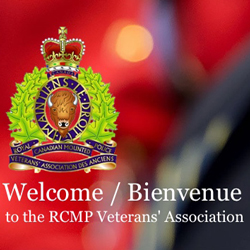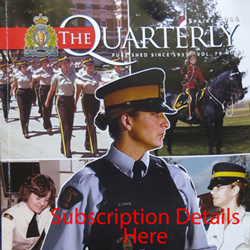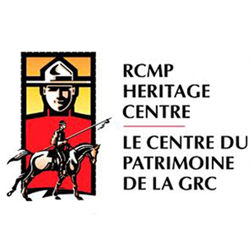The Caparisoned Horse

Veteran Ric Hall developed and provided us the following article for your reading pleasure.
Right off the top you are probably asking yourself what is a “The Caparisoned Horse”. It is the practice of having a horse of a deceased military officer led in the funeral procession is a remnant of an ancient custom of sacrificing a horse at the burial of a warrior. Generally the horse was hooded, sheathed in a cloth or armored covering and bore a saddle with the stirrups inverted and a sword through them. This further symbolized the fact that the deceased had fallen as a warrior and would ride no more. The entire caparison (the ornamented covering) is black. The hood, saddle blanket and cape are made of wool or serge (a strong, twilled fabric with diagonal rib). All brass and leather is highly polished.
What has this got to do with the RCMP you might ask. After the funeral of Constable Sarah Beckett on Vancouver Island following her tragic death in a collision with another vehicle many members have asked “why the horse with the boots reversed in the stirrup?” Hopefully, I can provide some background regarding the boots reversed.

Photograph of Constable Sarah Beckett’s funeral Procession led by a riderless horse with boots reversed (Source of photo – Ric Hall’s Photo Collection).
The empty boots facing backward in the stirrups had two levels of meaning. First, their being empty indicated the individual would ride no more. Secondly, they suggested the deceased was taking one last look back at his family and the troops he commanded. Both of these meanings carry forward to today’s tradition of boots reversed in the stirrups.
Leading the riderless horse for Constable Beckett was Constable Darby Klekta of Campbell River Detachment. The horse, Paco, is her own. Paco is a 14 year old Canadian Warmblood gelding and stands 16.2 hand high and is a competitive show jumper. Darby was honoured to be asked to lead her horse in the funeral procession “as I was at “Depot” with Sarah and personally knew her from her posting in my home town of Port McNeil. Maintiens le Droit Sarah.”
I thought it would easy to find information of “why the reversed boots?” As the RCMP retains many regimental traditions from the British, it would a simple task….not so! I could find very little written on the subject from the British military.
From the Official U.S. State Funeral Joint Force Headquarters, National Capital Region; “In order for the caparisoned horse to be used, the person it is honouring must have at one time been an Army or Marine Corps colonel or above. Since the president of the United States is the commander-in-chief of the armed forces, he is authorized a caparisoned horse in the procession.”
The RCMP Ceremonial and Protocol Guide states the following; “In a full regimental funeral where a procession is to take place, a charger will be led by a Cst./Junior NCO immediately behind the insignia bearer. The jack boots of the deceased will be place reversed in the stirrups with heels to the front, i.e. left boot in the right stirrup.” There is no mention of rank or if the member must have died in the line of duty.
For many of us of a certain age will always remember the assassination of President John F. Kennedy, November 23, 1963, and the days of mourning that followed and the funeral procession with muffled drums beating and a riderless horse. The riderless horse who took part in JFK’s funeral procession would become renowned: Black Jack, who would represent the mount of a fallen leader in the processions for Kennedy, Presidents Herbert Hoover (1964) and Lyndon B. Johnson (1973), as well as General Douglas MacArthur (1964), among other prominent Americans.

The spirited “Black Jack” leading JFK’s funeral Procession (Source of photo – Ric Hall’s Photo Collection).
The spirited “Black Jack” leading JFK’s funeral procession.
The protocol for Black Jack in Kennedy’s funeral procession would set the standard for riderless horses from 1963 to the present day. He was tacked with a black modified English riding saddle and black bridle. Black, spurred cavalry boots faced backward in the stirrups, and a scabbard with sword hung from the rear of the saddle’s right side. Positioned beneath the saddle, a heavy saddle cloth, or saddle blanket, was ornamental in design.
He was a military horse named in honour of General of the Armies John J. “Black Jack” Pershing. He was not a tall horse – 15 hands, weighing 1,050 pounds – but he had a big personality and was spirited. The magnificent black gelding, with an empty saddle, saber, and boots reversed in the stirrups, followed the caisson bearing the President’s coffin. The riderless horse is one of the highest military honors bestowed upon the fallen. Black Jack was from the Army’s oldest active infantry unit, the 3rd U.S. Infantry Regiment, known as The Old Guard. He alone defied the strict military discipline of the day with his rowdy behavior: prancing, throwing his head, and dancing around his walker. Mourners liked his spirited nature, however, and so his unmilitary antics were tolerated. Those antics continued until he was retired in 1973 after participating in several thousand funerals.
After the funeral, Mrs. Kennedy, an avid horsewoman, expressed an interest in Black Jack. Within hours, the horse’s saddle and blanket, and the boots and saber were delivered to her at the White House.
When Black Jack passed away in 1976, his remains were cremated and his ashes buried with full military honours. A monument on the parade ground at Fort Myer’s Summerall Field attests to the degree he had been revered.

Photograph of President Ronald Reagan’s funeral and the riderless horse, Sgt. Kor, carries the President’s reversed Personal riding boots (Source of photo – Ric Hall’s Photo Collection).
I have personally been involved in some of the Force’s largest funeral processions for members killed in the line of duty and have never seen the riderless horse used. The first time during my service, and after, that I have seen a riderless horse used was in the procession, January 26, 2015, for Constable David Wynn in St Albert, AB.

Photograph of the funeral procession for Constable David Wynn (Source of photo – Ric Hall’s Photo Collection).
In looking through my collection of photographs of the early days of the NWMP/RNWMP and RCMP there is clear evidence of the Force using the comparisoned horse during regimental funerals. Perhaps that a sword or sabre is not shown indicates that rank is not requisite for the use of the riderless horse. Unfortunately, I do not have a name/rank associated to the funerals.

The RNWMP version of the caparisoned horse (Source of photo – Ric Hall’s Photo Collection).

Photograph of caparisoned horse without the cape (Source of photo – Ric Hall’s Photo Collection).

Photograph of caparisoned horse without the cape (Source of photo – Ric Hall’s Photo Collection).
Now you know what a comparisoned horse is and why there is a riderless horse with boots reversed in regimental funerals. To those who are more knowledgeable in such things, if I have made historical or factual mistakes with regard to the Force’s use of the caparisoned horse it is on me and I am sure someone will let me know where I have erred.
To end this article on an upbeat note. I have added a picture of Constable Darby Klekta riding her other horse, Tosca, a 32 year old Thoroughbred mare on Stones Beach near Campbell River. The photographs were taken by Campbell River photographer Erin Wallis.


Happy trails to you Constable Klekta!



 June 4, 2016
June 4, 2016 






